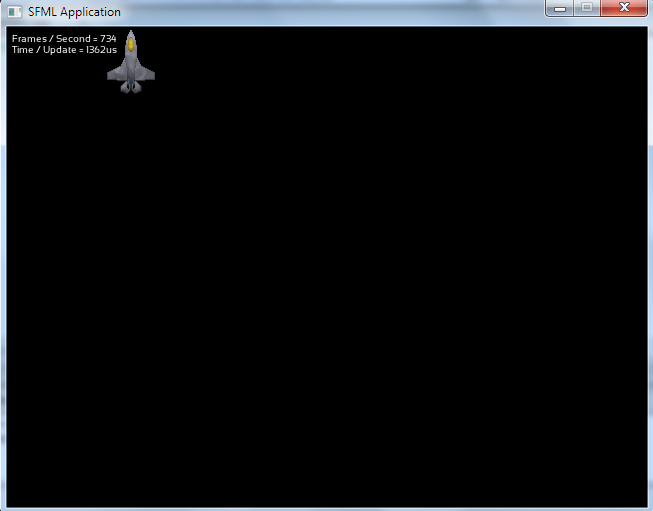Before you read anything, note that this probably isn't what you'd call a "complete and minimal example" (at least, not the second spoiler of code, although both aren't
terribly long), so if you don't feel like trying to figure out why my performance is horrible, please don't waste your time for me, I understand!
This is the Object Collision I've been working on.
- mPlayer is an sf::RectangleShape
- mWalls is an std::vector<sf::RectangleShape>
This may look long, but it is an example is for a very basic case:
The player is a direct member of the game class.
The walls are direct members of the game class.
This handles
top-down, 8-directional movement.
For both x-axis movment and y-axis movement, if it is colliding with a wall, it finds how far the Player is into the wall, and moves it back by that difference amount.
/**
* Handles moving the player,
* and Player-Wall object collision.
*/
void Game::updatePlayer(sf::Time deltaTime)
{
sf::Vector2f movement(0.f, 0.f);
float difference = 0.0f;
/////////////////////////
/// X-Axis Movement ///
/////////////////////////
if (mIsMovingLeft)
movement.x -= PlayerSpeed;
if (mIsMovingRight)
movement.x += PlayerSpeed;
mPlayer.move(movement.x * deltaTime.asSeconds(), 0);
sf::FloatRect currPlayerRect = mPlayer.getGlobalBounds();
/// X-Axis Player-Wall Collision ///
for (int i = 0; i < mWalls.size(); i++)
{
if (mPlayer.getGlobalBounds().intersects(mWalls[i].getGlobalBounds()))
{
if (mIsMovingLeft)
{
difference = mWalls[i].getGlobalBounds().left
+ mWalls[i].getGlobalBounds().width
- currPlayerRect.left;
mPlayer.move(difference, 0);
}
else if (mIsMovingRight)
{
difference = currPlayerRect.left + currPlayerRect.width
- mWalls[i].getGlobalBounds().left;
mPlayer.move(-difference, 0);
}
}
}
/////////////////////////
/// Y-Axis Movement ///
/////////////////////////
if (mIsMovingUp)
movement.y -= PlayerSpeed;
if (mIsMovingDown)
movement.y += PlayerSpeed;
mPlayer.move(0, movement.y * deltaTime.asSeconds());
currPlayerRect = mPlayer.getGlobalBounds();
/// Y-Axis Player-Wall Collision ///
for (int i = 0; i < mWalls.size(); i++)
{
if (mPlayer.getGlobalBounds().intersects(mWalls[i].getGlobalBounds()))
{
if (mIsMovingUp)
{
difference = mWalls[i].getGlobalBounds().top
+ mWalls[i].getGlobalBounds().height
- currPlayerRect.top;
mPlayer.move(0, difference);
}
else if (mIsMovingDown)
{
difference = currPlayerRect.top + currPlayerRect.height
- mWalls[i].getGlobalBounds().top;
mPlayer.move(0, -difference);
}
}
}
}
The X- and Y-Axis movements are separated to allow for sliding. I'm not sure if there's a better way to do this, but that isn't really the problem right now.
Basically, the above code works great. It seems to be handle 10,000 sf::RectangleShape objects (the walls) just fine (the problem with 10000 rectangles is drawing them all, but that's unrelated, and was just a performance test).
HOWEVER, when I tried to "apply" this code to a more complicated project, the performance is unbearable against even a not-so-high number of walls (I believe around 40 or 80 rectangles).
// game.cpp
void Game::update(sf::Time deltaTime)
{
//Player movement:
mPlayer.update(deltaTime, *this);
// player.cpp
void Player::update(sf::Time deltaTime, const Game &game)
{
sf::Vector2f movement(0.f, 0.f);
float difference = 0.0f;
int currentRoom = game.getCurrentRoom();
/////////////////////////
/// X-Axis Movement ///
/////////////////////////
if (mIsMovingLeft)
movement.x -= Speed;
if (mIsMovingRight)
movement.x += Speed;
mBody.move(movement.x * deltaTime.asSeconds(), 0);
/// X-Axis Player-Wall Collision ///
sf::FloatRect currPlayerRect = mBody.getGlobalBounds();
for (unsigned int i = 0; i < game.getRooms()[currentRoom].getInnerWalls().size(); i++)
{
if (mBody.getGlobalBounds().intersects(game.getRooms()[currentRoom].getInnerWalls()[i].getGlobalBounds()))
{
if (mIsMovingLeft)
{
difference = game.getRooms()[currentRoom].getInnerWalls()[i].getGlobalBounds().left
+ game.getRooms()[currentRoom].getInnerWalls()[i].getGlobalBounds().width
- currPlayerRect.left;
mBody.move(difference, 0);
}
else if (mIsMovingRight)
{
difference = currPlayerRect.left + currPlayerRect.width
- game.getRooms()[currentRoom].getInnerWalls()[i].getGlobalBounds().left;
mBody.move(-difference, 0);
}
}
}
/////////////////////////
/// Y-Axis Movement ///
/////////////////////////
if (mIsMovingUp)
movement.y -= Speed;
if (mIsMovingDown)
movement.y += Speed;
mBody.move(0, movement.y * deltaTime.asSeconds());
/// Y-Axis Player-Wall Collision ///
currPlayerRect = mBody.getGlobalBounds();
for (unsigned int i = 0; i < game.getRooms()[currentRoom].getInnerWalls().size(); i++)
{
if (mBody.getGlobalBounds().intersects(game.getRooms()[currentRoom].getInnerWalls()[i].getGlobalBounds()))
{
if (mIsMovingUp)
{
difference = game.getRooms()[currentRoom].getInnerWalls()[i].getGlobalBounds().top
+ game.getRooms()[currentRoom].getInnerWalls()[i].getGlobalBounds().height
- currPlayerRect.top;
mBody.move(0, difference);
}
else if (mIsMovingDown)
{
difference = currPlayerRect.top + currPlayerRect.height
- game.getRooms()[currentRoom].getInnerWalls()[i].getGlobalBounds().top;
mBody.move(0, -difference);
}
}
}
}
I am sure that it's the Object Collision part of the code that's causing the unplayable performance in the second block of code, it can handle the draw calls just fine when I comment out the X- and Y-collision segments. I understand that implementing a Quad-tree or something would increase performance, but the problem here is definitely something that should be fixed at its source instead of trying to cut around, especially with so little walls.
Anyway, so, if you have the time, please look through and compare the two blocks of code I have. I can see why the second block of code is more complicated, but the performance hit is
unbearable, and I don't understand why this disparity exists!
EDIT:Okay, so I've been tinkering with it some more, and so far it seems to be that the accessor "getter" methods that are causing the most problems.
doing this:
int num_walls = game.getRooms()[currentRoom].getInnerWalls().size();
for (unsigned int i = 0; i < num_walls; i++)
{ /*commented out code*/}
compared to this:
for (unsigned int i = 0; i < game.getRooms()[currentRoom].getInnerWalls().size(); i++)
{ /*commented out code*/}
seems to give a huge performance boost right off the bat...
my get___() methods are currently returning the member itself, nothing special.
ex:
std::vector<sf::RectangleShape> Game::getRooms()
{
return mRooms;
}
Would returning a reference instead really save that much performance? Sorry if that's more of a C++ question than an SFML one...


